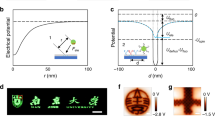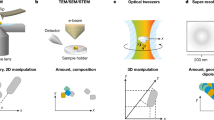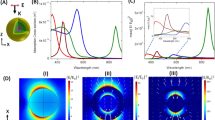Abstract
Combining multiple discrete components into a single multifunctional nanoparticle could be useful in a variety of applications. Retaining the unique optical and electrical properties of each component after nanoscale integration is, however, a long-standing problem1,2. It is particularly difficult when trying to combine fluorophores such as semiconductor quantum dots with plasmonic materials such as gold, because gold and other metals can quench the fluorescence3,4. So far, the combination of quantum dot fluorescence with plasmonically active gold has only been demonstrated on flat surfaces5. Here, we combine fluorescent and plasmonic activities in a single nanoparticle by controlling the spacing between a quantum dot core and an ultrathin gold shell with nanometre precision through layer-by-layer assembly. Our wet-chemistry approach provides a general route for the deposition of ultrathin gold layers onto virtually any discrete nanostructure or continuous surface, and should prove useful for multimodal bioimaging6, interfacing with biological systems7, reducing nanotoxicity8, modulating electromagnetic fields5 and contacting nanostructures9,10.
This is a preview of subscription content, access via your institution
Access options
Subscribe to this journal
Receive 12 print issues and online access
$259.00 per year
only $21.58 per issue
Buy this article
- Purchase on Springer Link
- Instant access to full article PDF
Prices may be subject to local taxes which are calculated during checkout




Similar content being viewed by others
References
Mokari, T., Rothenberg, E., Popov, I., Costi, R. & Banin, U. Selective growth of metal tips onto semiconductor quantum rods and tetrapods. Science 304, 1787–1790 (2004).
Mokari, T., Sztrum, C. G., Salant, A., Rabani, E. & Banin, U. Formation of asymmetric one-sided metal-tipped semiconductor nanocrystal dots and rods. Nature Mater. 4, 855–863 (2005).
Dubertret, B., Calame, M. & Libchaber, A. J. Single-mismatch detection using gold-quenched fluorescent oligonucleotides. Nature Biotechnol. 19, 365–370 (2001).
Pons, T. et al. On the quenching of semiconductor quantum dot photoluminescence by proximal gold nanoparticles. Nano Lett. 7, 3157–3164 (2007).
Kulakovich, O. et al. Enhanced luminescence of CdSe quantum dots on gold colloids. Nano Lett. 2, 1449–1452 (2002).
Cai, W. B. & Chen, X. Y. Nanoplatforms for targeted molecular imaging in living subjects. Small 3, 1840–1854 (2007).
Elghanian, R., Storhoff, J. J., Mucic, R. C., Letsinger, R. L. & Mirkin, C. A. Selective colorimetric detection of polynucleotides based on the distance-dependent optical properties of gold nanoparticles. Science 277, 1078–1081 (1997).
Derfus, A. M., Chan, W. C. W. & Bhatia, S. N. Probing the cytotoxicity of semiconductor quantum dots. Nano Lett. 4, 11–18 (2004).
Haick, H. & Cahen, D. Contacting organic molecules by soft methods: towards molecule-based electronic devices. Acc. Chem. Res. 41, 359–366 (2008).
Hipps, K. W. Molecular electronics: It's all about contacts. Science 294, 536–537 (2001).
Pillai, S., Catchpole, K. R., Trupke, T. & Green, M. A. Surface plasmon enhanced silicon solar cells. J. Appl. Phys. 101, 093105 (2007).
Shimizu, K. T., Woo, W. K., Fisher, B. R., Eisler, H. J. & Bawendi, M. G. Surface-enhanced emission from single semiconductor nanocrystals. Phys. Rev. Lett. 89, 117401 (2002).
Pompa, P. P. et al. Metal-enhanced fluorescence of colloidal nanocrystals with nanoscale control. Nature Nanotech. 1, 126–130 (2006).
Chang, E. et al. Protease-activated quantum dot probes. Biochem. Biophys. Res. Commun. 334, 1317–1321 (2005).
Baer, R., Neuhauser, D. & Weiss, S. Enhanced absorption induced by a metallic nanoshell. Nano Lett. 4, 85–88 (2004).
Jain, P. K., El-Sayed, I. H. & El-Sayed, M. A. Au nanoparticles target cancer. Nano Today 2, 18–29 (2007).
Murphy, C. J. et al. Gold nanoparticles in biology: beyond toxicity to cellular imaging. Acc. Chem. Res. 41, 1721–1730 (2008).
Liao, S. Y. Light transmittance and RF shielding effectiveness of a gold film on a glass substrate. IEEE Trans. Electromagn. Compat. EMC-17, 211–216 (1975).
Hirsch, L. R. et al. Metal nanoshells. Ann.Biomed. Eng. 34, 15–22 (2006).
Oldenburg, S. J., Averitt, R. D., Westcott, S. L. & Halas, N. J. Nanoengineering of optical resonances. Chem. Phys. Lett. 288, 243–247 (1998).
Reith, F., Rogers, S. L., McPhail, D. C. & Webb, D. Biomineralization of gold: biofilms on bacterioform gold. Science 313, 233–236 (2006).
Djalali, R., Chen, Y.-F. & Matsui, H. Au nanocrystal growth on nanotubes controlled by conformations and charges of sequenced peptide templates. J. Am. Chem. Soc. 125, 5873–5879 (2003).
Janknecht, R. et al. Rapid and efficient purification of native histidine-tagged protein expressed by recombinant vaccinia virus. Proc. Natl Acad. Sci. USA 88, 8972–8976 (1991).
Dubertret, B. et al. In vivo imaging of quantum dots encapsulated in phospholipid micelles. Science 298, 1759–1762 (2002).
Son, D. H., Hughes, S. M., Yin, Y. & Alivisatos, A. P. Cation exchange reactions in ionic nanocrystals. Science 306, 1009–1012 (2004).
Caruso, F. Nanoengineering of particle surfaces. Adv. Mater. 13, 11–22 (2001).
Chen, H. Y. et al. Encapsulation of single small gold nanoparticles by diblock copolymers. ChemPhysChem 9, 388–392 (2008).
Park, J., Joo, J., Kwon, S. G., Jang, Y. & Hyeon, T. Synthesis of monodisperse spherical nanocrystals. Angew Chem. Int. Ed. 46, 4630–4660 (2007).
Medintz, I. L., Uyeda, H. T., Goldman, E. R. & Mattoussi, H. Quantum dot bioconjugates for imaging, labelling and sensing. Nature Mater. 4, 435–446 (2005).
Michalet, X. et al. Quantum dots for live cells, in vivo imaging and diagnostics. Science 307, 538–544 (2005).
Wang, Z. L. Transmission electron microscopy of shape-controlled nanocrystals and their assemblies. J. Phys. Chem. B 104, 1153–1175 (2000).
Lu, X., Yavuz, M. S., Tuan, H.-Y., Korgel, B. A. & Xia, Y. Ultrathin gold nanowires can be obtained by reducing polymeric strands of oleylamine–AuCl complexes formed via aurophilic interaction. J. Am. Chem. Soc. 130, 8900–8901 (2008).
Wang, C. & Sun, S. H. Facile synthesis of ultrathin and single-crystalline Au nanowires. Chem.-Asian J. 4, 1028–1034 (2009).
Acknowledgements
This work was supported in part by NIH (R01 CA131797, NSF, 0645080), the Seattle Foundation and the Department of Bioengineering at the University of Washington. X.G. thanks the NSF for a Faculty Early Career Development award (CAREER). We are especially grateful to T. Kavanagh and D. Eaton for fruitful discussions on nanotoxicity, UW Nanotech User Facility for HRTEM, Z. Wang and Y. Ding for TEM image interpretation, D. Chiu and D. Ginger for critical reading of the manuscript and D. Zhang for help with computer graphics.
Author information
Authors and Affiliations
Contributions
Y.J. and X.G. conceived and designed the experiments. Y.J. performed the experiments. Y.J. and X.G. analysed and discussed the data. X.G. wrote the paper.
Corresponding author
Supplementary information
Supplementary information
Supplementary information (PDF 340 kb)
Rights and permissions
About this article
Cite this article
Jin, Y., Gao, X. Plasmonic fluorescent quantum dots. Nature Nanotech 4, 571–576 (2009). https://doi.org/10.1038/nnano.2009.193
Received:
Accepted:
Published:
Issue Date:
DOI: https://doi.org/10.1038/nnano.2009.193
This article is cited by
-
Improving the luminous efficiency of quantum dot-converted LEDs by doping boron nitride nanoparticles
Optical Review (2023)
-
Fabrication of Hybrid Nanostructures Based on Fe3O4 Nanoclusters as Theranostic Agents for Magnetic Resonance Imaging and Drug Delivery
Nanoscale Research Letters (2019)
-
Reduced graphene oxide nanosheets modified with plasmonic gold-based hybrid nanostructures and with magnetite (Fe3O4) nanoparticles for cyclic voltammetric determination of arsenic(III)
Microchimica Acta (2019)
-
Plasmon-exciton interaction in colloidally fabricated metal nanoparticle-quantum emitter nanostructures
Nano Research (2019)
-
Practical Three-Minute Synthesis of Acid-Coated Fluorescent Carbon Dots with Tuneable Core Structure
Scientific Reports (2018)



